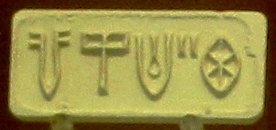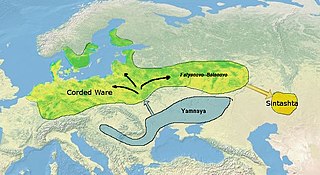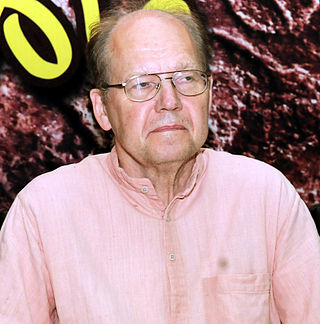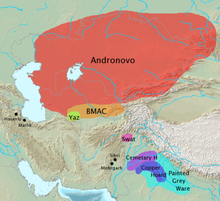
The Dravidian languages are a family of languages spoken by 250 million people, mainly in southern India, north-east Sri Lanka, south-west Pakistan and some regions of Nepal. Dravidian is first attested in the 2nd century BCE, as inscriptions in Tamil-Brahmi script on cave walls in the Madurai and Tirunelveli districts of Tamil Nadu.

The Proto-Indo-Europeans are a hypothetical prehistoric ethnolinguistic group of Eurasia who spoke Proto-Indo-European (PIE), the reconstructed common ancestor of the Indo-European language family.

The historical Vedic religion, also known as Vedicism and Vedism, constituted the religious ideas and practices prevalent amongst the Indo-Aryan peoples of the northwest Indian subcontinent during the Vedic period. These ideas and practices are found in the Vedic texts, and some Vedic rituals are still practiced today. The Vedic religion is one of the major traditions which shaped Hinduism, though present-day Hinduism is significantly different from the historical Vedic religion.

The Elamo-Dravidian language family is a hypothesised language family that links the Elamite language of ancient Elam to the Dravidian languages of South Asia. The latest version (2015) of the hypothesis entails a reclassification of Brahui as being more closely related to Elamite than to the remaining Dravidian languages. Linguist David McAlpin has been a chief proponent of the Elamo-Dravidian hypothesis, followed by Franklin Southworth as the other major supporter. The hypothesis has gained attention in academic circles, but has been subject to serious criticism by linguists, and remains only one of several possible scenarios for the origins of the Dravidian languages. Elamite is generally accepted by scholars to be a language isolate, unrelated to any other known language.

The Indus script, also known as the Harappan script and the Indus Valley Script, is a corpus of symbols produced by the Indus Valley Civilisation. Most inscriptions containing these symbols are extremely short, making it difficult to judge whether or not they constituted a writing system used to record a Harappan language, any of which are yet to be identified. Despite many attempts, the "script" has not yet been deciphered, but efforts are ongoing. There is no known bilingual inscription to help decipher the script, which shows no significant changes over time. However, some of the syntax varies depending upon location.

The Indo-Iranian peoples, also known as Ā́rya or Aryans from their self-designation, were a group of Indo-European speaking peoples who brought the Indo-Iranian languages to major parts of Eurasia in waves from the first part of the 2nd millennium BC onwards. They eventually branched out into the Iranian peoples and Indo-Aryan peoples.
Edwin Francis Bryant is an American Indologist. Currently, he is professor of religions of India at Rutgers University. He published seven books and authored a number of articles on Vedic history, yoga, and the Krishna tradition. In his research engagements, he lived several years in India where he studied Sanskrit and was trained with several Indian pundits.

The Indo-Aryan migrations were the migrations into the Indian subcontinent of Indo-Aryan peoples, an ethnolinguistic group that spoke Indo-Aryan languages. These are the predominant languages of today's Bangladesh, Maldives, Nepal, North India, Eastern Pakistan, and Sri Lanka.

Asko Parpola is a Finnish Indologist, current professor emeritus of South Asian studies at the University of Helsinki. He specializes in Sindhology, specifically the study of the Indus script.

The horse has been present in the Indian subcontinent from at least the middle of the second millennium BC, more than two millennia after its domestication in Central Asia. The earliest uncontroversial evidence of horse remains on the Indian Subcontinent date to the early Swat culture .While horse remains and related artifacts have been found in Late Harappan sites, indicating that horses may have been present at Late Harappan times, horses did not play an essential role in the Harappan civilisation, in contrast to the Vedic period. The importance of the horse for the Indo-Aryans is indicated by the Sanskrit word Ashva, "horse," which is often mentioned in the Vedas and Hindu scriptures.
Vedic Sanskrit has a number of linguistic features which are alien to most other Indo-European languages. Prominent examples include: phonologically, the introduction of retroflexes, which alternate with dentals, and morphologically, the formation of gerunds. Some philologists attribute such features, as well as the presence of non-Indo-European vocabulary, to a local substratum of languages encountered by Indo-Aryan peoples in Central Asia (Bactria-Marghiana) and within the Indian subcontinent during Indo-Aryan migrations, including the Dravidian languages.

Indigenous Aryanism, also known as the Indigenous Aryans theory (IAT) and the Out of India theory (OIT), is the conviction that the Aryans are indigenous to the Indian subcontinent, and that the Indo-European languages radiated out from a homeland in India into their present locations. It is a "religio-nationalistic" view on Indian history, and propagated as an alternative to the established migration model, which considers the Pontic–Caspian steppe to be the area of origin of the Indo-European languages.

The Dravidian peoples are an ethnolinguistic supraethnicity composed of many distinct ethnolinguistic groups native to South Asia. They speak the Dravidian languages, which have a combined total of about 250 million native speakers. Dravidians form the majority of the population of South India and Northern Sri Lanka.

The Proto-Indo-European homeland was the prehistoric linguistic homeland of the Proto-Indo-European language (PIE). From this region, its speakers migrated east and west, and went on to form the proto-communities of the different branches of the Indo-European language family.

The Vedic period, or the Vedic age, is the period in the late Bronze Age and early Iron Age of the history of India when the Vedic literature, including the Vedas, was composed in the northern Indian subcontinent, between the end of the urban Indus Valley Civilisation and a second urbanisation, which began in the central Indo-Gangetic Plain c. 600 BCE. The Vedas are liturgical texts which formed the basis of the influential Brahmanical ideology, which developed in the Kuru Kingdom, a tribal union of several Indo-Aryan tribes. The Vedas contain details of life during this period that have been interpreted to be historical and constitute the primary sources for understanding the period. These documents, alongside the corresponding archaeological record, allow for the evolution of the Indo-Aryan and Vedic culture to be traced and inferred.

Aryan or Arya is a term originally used as an ethnocultural self-designation by Indo-Iranians in ancient times, in contrast to the nearby outsiders known as 'non-Aryan'. In Ancient India, the term ā́rya was used by the Indo-Aryan speakers of the Vedic period as an endonym (self-designation) and in reference to a region known as Āryāvarta, where the Indo-Aryan culture emerged. In the Avesta scriptures, ancient Iranian peoples similarly used the term airya to designate themselves as an ethnic group, and in reference to their mythical homeland, Airyanǝm Vaēǰō. The stem also forms the etymological source of place names such as Alania and Iran.

The peopling of India refers to the migration of Homo sapiens into the Indian subcontinent. Anatomically modern humans settled India in multiple waves of early migrations, over tens of millennia. The first migrants came with the Coastal Migration/Southern Dispersal 65,000 years ago, whereafter complex migrations within South and Southeast Asia took place. West-Asian (Iranian) hunter-gatherers migrated to South Asia after the Last Glacial Period but before the onset of farming. Together with ancient South Asian hunter-gatherers they formed the population of the Indus Valley Civilisation (IVC).

The Indo-European migrations are hypothesized migrations of Proto-Indo-European language (PIE) speakers, and subsequent migrations of people speaking derived Indo-European languages, which took place approx. 4000 to 1000 BCE, potentially explaining how these languages came to be spoken across a large area of Eurasia, spanning from the Indian subcontinent and Iranian plateau to Atlantic Europe, in a process of cultural diffusion.

Proto-Indo-Aryan is the reconstructed proto-language of the Indo-Aryan languages. It is intended to reconstruct the language of the Proto-Indo-Aryans, who had migrated into the Indian subcontinent. Being descended from Proto-Indo-Iranian, it has the characteristics of a Satem language.















